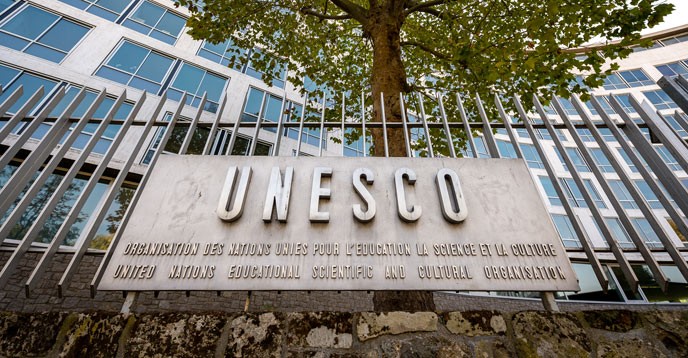
UNESCO headquarters in Paris, France. Photo:UNESCO
Paris (People's Daily) – UNESCO held an opening night gala for its new exhibition honoring Chinese Buddhist culture on November 21. “An Evening of Chinese Buddhist Culture” at their Paris headquarters on November 21.
The exhibit features a photo series titled Buddhist Culture in Countries along the Belt and Road Path, a traditional Yunlin tea ceremony performed by Buddhist monks, and original paintings on contemporary Chinese Buddhist art.
Shen Yang, ambassador and permanent delegate of China to UNESCO, gave a moving speech during the opening ceremony.
H.E. Ambassador Shen remembered the time when Chinese President Xi Jinping made his historic visit to UNESCO headquarters in March 2014.
“Civilizations have become richer and more colorful with exchanges and mutual learning. Such exchanges and mutual learning form an important drive for human progress and global peace and development,” said Shen, quoting President Xi, from his 2014 visit.
“This Evening of Chinese Buddhist Culture is a testimony to this statement,” Shen elaborated.
“The photo exhibition Buddhist Culture in Countries along the Belt and Road, the Yunlin Tea Ceremony, and the Contemporary Chinese Buddhist Art Exhibition are all repositories of people-to-people exchange. They are about the flow of knowledge and people, and how cultures thrived because they had been enriched through exchanges and mutual learning. They are embodiments of the Belt and Road Initiative’s spirit of peace and cooperation, openness and inclusiveness, mutual learning and mutual benefit,” said Shen.
Shen stressed that respect and protection for the freedom of religious beliefs has been a party of China’s fundamental and long-term national policy.
China discovered Buddhism over 2,000 years ago. It is one of the country’s major religious beliefs, along with Islam, Taosim, and Christianity.
Lingyin Temple is one of the largest and most prestigious Buddhist monasteries in China, with a history dating back more than 1,800 years. It is renowned its preservation of Buddhist heritage and traditional Chinese culture. Buddhism’s long history and rich culture are both shared by many throughout the world.
The Chinese Buddhist Culture Exhibition provides a great opportunity for UNESCO and guests to achieve a deeper understanding of the art in the new millennium.
The photo exhibition is a moving display of photographed images showcasing Buddhist holy sites and the spiritual lives found in Belt and Road nations such as China, India, Nepal, Bhutan, Thailand, Myanmar, Lao, Cambodia, Indonesia and Sri Lank.
The Yunlin Tea Ceremony, performed by specially trained Buddhist monks, offers people a chance to experience the kind of peace and harmony that is necessary for humanity to flourish.
There’s also a contemporary art exhibit, featuring work by artists from Zhejiang Province, whose paintings reflect the modern spirit of Chinese Buddhist culture.


